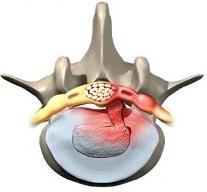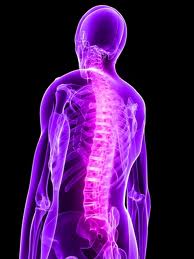Herniated Disc - Sciatica

What is the herniated disc?
It is a displacement of the intervertebral disc can occur at various levels, cervical, thoracic or lumbar; disc herniation causes compression and damage to the nerve roots coming out of each vertebral level with the consequent pain and motor disability.
Symptoms
Back pain, this may be in the cervical region of the neck. In the most common thoracic and lumbar region, which may be known a sciatica.
The treatment called: Discolysis
This is the newest treatment of disc herniations in which ozone is applied directly to disc through instrumentation, is an European technique, widely used in Italy, Germany and Spain, requires no anesthesia and doesn’t need hospitalization.
It’s not open surgery; no after effects and requires little incapacitating; success is between 82% – 96% and at a lower cost.
 Dorsal spinal cord has 33 vertebrae separated by intervertebral discs.
Dorsal spinal cord has 33 vertebrae separated by intervertebral discs.
Disc herniations occur in any area of the spine, the most common are in the lumbar vertebrae (back pain).
The disc is located between each of the bony parts of the column. They act as shock absorbers to absorbe the impact.
The disc consists of 2 parts:
1. Outer fibrous tough, fibrous ring.
2. Internal, soft gelatinous nucleus pulposus.
Herniated disc
 It is caused by disc degeneration or by a continuous pressure (overweight) column nucleus pulposus the annulus exits compressing nerve roots (LBP).
It is caused by disc degeneration or by a continuous pressure (overweight) column nucleus pulposus the annulus exits compressing nerve roots (LBP).
Symptoms
Local and irradiated to type or electric leg cramp, weakness pain over time, there is decreased leg strength, numbness in the buttocks, knees or toes, eventually lost sensitivity in the affected leg.
Diagnosis
 Through a clinical history and examination with the signs of pain and nerve compression.
Through a clinical history and examination with the signs of pain and nerve compression.
simple and dynamic RX column, positron
Axial or magnetic resonance imaging (R.M.N.), Ozone treatment is a novel and well documented treatment.
The results are equal or better than with surgery 85- 90% of good answers, does not require general anesthesia, it is ambulatory (no need hospitalization) leaves no scar problems and recovery is almost immediate, complications are minimal.
The treatment is supplemented by:
1.- Ozone sessions on the sides of the column.
2. Electrical nerve stimulation (interferential).
3. Ultrasound antiinflammatory.
